Based on a stage melodrama which was itself based on a story by Scott Marble, The Great Train Robbery (1903) is often attributed as being the first narrative film, the majority of films until that time having been void of plot.
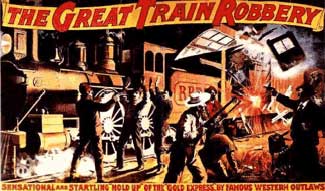 In reality director Edwin S. Porter was fired with enthusiasm for making a film with narrative drive only after seeing Georges Melies A Trip to the Moon (1902), & even that wasn't the first narrative film though it was the first internationally successful one. Porter's western would be the second.
In reality director Edwin S. Porter was fired with enthusiasm for making a film with narrative drive only after seeing Georges Melies A Trip to the Moon (1902), & even that wasn't the first narrative film though it was the first internationally successful one. Porter's western would be the second.
Porter stated that filmmaking had come to a stale dead-end with its two-minute snippets & jests, & it was Melies that showed him the vitality of the future of cinema.
Porter added many innovations in editing technique & other advances, & ended up defining for American cinema the whole notion of "the western movie." And eventually even Melies' brother Gaston, running the New York office of Melies Star Films, would be travelling out west for location-shot westerns.
Action oriented from the first scene, two masked gunmen break into the railroad's telegraph office & knock the clerk unconsious, tie him up, & gag him. Even in just that first scene The Great Train Robbery captured a look that would remain with westerns for as long as there was cinema.
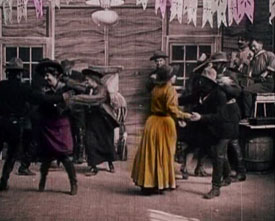 The train pulls in beneath the water tower & three masked cowboys slip onto the train unseen. Soon there's a shoot-out in the mail car, a man is killed, & the thieves use explosives to open a payrole chest. The train pulls in beneath the water tower & three masked cowboys slip onto the train unseen. Soon there's a shoot-out in the mail car, a man is killed, & the thieves use explosives to open a payrole chest.
Scurring over the top of the coal car to get the train engineer, there's a fight on top of the train, the engineer is forced to stop, the two robbers force the engineer to separate the locomotive from the train cars.
All passengers are forced off the train cars & lined up with hands raised & deprived of their valuables. One man makes a break for it & is gunned down. The robbers then load onto the locomotive forcing the engineer to drop them off further along the line, where a fourth robber awaits with horses.
Meanwhile the clerk back at the train station is found by his little daughter, who unties him & prays over him. There's a ho-down down the road a piece where the station master goes for help. The guys at the dance are immediately organized into a posse which with some hard riding.
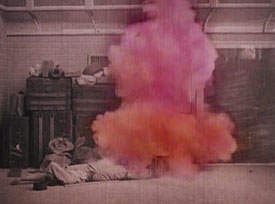 There's a chase sequence with blazing guns & one of the gang members is shot from his horse. The other three get away, but momentarily they are found off their horses dividing up their loot, resulting in a big shoot-out, the robbers slain in a blaze of smoking six-guns. There's a chase sequence with blazing guns & one of the gang members is shot from his horse. The other three get away, but momentarily they are found off their horses dividing up their loot, resulting in a big shoot-out, the robbers slain in a blaze of smoking six-guns.
After the story is completed, there's a coda with the gang leader looking straight out into the audience with realistic menace, aiming point blank at the viewers, & shoots us. That must've been damned startling in 1903.
The Great Train Robbery defined film action in ways that filmmakers emulate to this very day. The one down side is that Porter created an air of nonstop excitement without need of characterization. And that, too, has remained a trait of action cinema pretty much forever.
Inspired by the real train hold-ups of the four-man "Hole in the Wall" gang headed by George Leroy Parker aka Butch Cassidy, whatever characterization was brought to the film was brought by reputation & is not to be found in the film itself. Only a small percentage of the films were hand-tinted by wives of workers at the Edision Manufacturing Company, but a very nice tinted print has come down to us, from which a couple screen-captures illustrate this page.
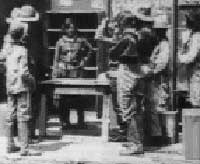 The Edison Manufacturing Co. did not take a great long while to get round to spoofing their own megahit, producing the action film The Little Train Robbery (1905). It's not entirely spoofy & works as real adventure film, but the casting of kids in all the roles guarantees it not being taken too seriously.
The Edison Manufacturing Co. did not take a great long while to get round to spoofing their own megahit, producing the action film The Little Train Robbery (1905). It's not entirely spoofy & works as real adventure film, but the casting of kids in all the roles guarantees it not being taken too seriously.
A gang of cowboys including a cowgirl, "the bandit queen" who is the ringleader, gather in their cabin hide-out, initiating a new gang member, then laying plans for the train heist.
They're next seen breaking into a barn. They steal horses, ride to the half-sized railroad tracks, don masks, lay boards on the tracks. Soon there comes chuggin' along a pint-sized train pulling carts full of smartly dressed young ladies.
The damsels are lined up & deprived of their valuables. The little locomotive & coal car are separated from the carts & the whole gang piles on the coal car & off they go a-chuggin' through the park.
Dismembarking a little ways on, they return to their horses & skidaddle out of there, speeding along back roads. In hot pursuit, on foot but losing no distance, are a group of policemen with bobby hats, police uniforms with s tripe down the sides of their pantlegs, & batons, precursors to the Keystone cops, absurdly out of place as western setting.
At the cabin headquarters the ringleader cowgirl & a couple friends greet the gang & the loot. The cops afoot are right behind, so the gang takes off running over the countryside, for an extended foot-chase.
The gang is chased to a dock & leap one by one into the river. But the cops were ready for them with a rowboat & the whole gang is captured. While being led off to jail, the cowgirl lags behind a bit & escapes quite easily.
Eager to horn in on Edwin Porter's megahit The Great Train Robbery (1903), Siegmund Lubin plagiarized it within the year as Great Train Robbery (1904).
Thomas Edison, whose own company committed just such plagiarisms time & time again, nevertheless used his muscle in court to stop the Lubin Film Company from distributing their copy. This was the beginning of civil law in support of copyright protections of creative properties. It was also a good example of the law belonging to the richest, as the Edison Manufacturing Company would continue their own plagiarisms unabated.
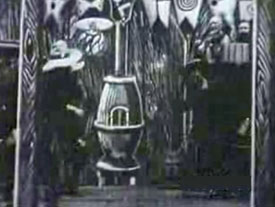 The Lubin catalog text for this story describes some scenes different from how they are actually filmed. The Lubin catalog text for this story describes some scenes different from how they are actually filmed.
Although it approaches being a scene by scene remake, it's condensed, with a few small distinctions of its own. It is a pretty good film in its own right, though at every bend cheaper than the original & unlike what he copied, no work of genius.
The train station/telegraph office looks more like a painted backdrop than a real set. Part of the backdrop is a "cut out" for the window, through which a train is shown rushing by.
When the train stops to take on water for the locomotive, that's when the robbers board the train. The mail car looks quite a bit like in the original film. Another backdrop cut-out mimics an open door, with the countryside rushing by. This was done as on live stages of the era. A long tarp with the painted scene was mounted on rollers & cranked at whatever speed was desired.
The robbers shoot the mail car worker dead, blow up a payroll box, & gather up two bags of mail & money before climbing onto the roof of the train for a momentary fight with a worker.
There really was often a worker on train roofs because the steam engines dropped sparks on passenger cars, requiring constant fire duty, & the train's rooftop firemen were usually pretty tough guys. So Porter was capturing, & Lubin copying, something that was real. Ever since, just about any film for which a train figures prominantly, the cast will be on the roof at one point or another.
The robbers stop the train & unhook the locomotive. They make the passengers get off the train & hold their hands up to be robbed, escaping in the locomotive. They stop the engine further on & flee afoot across the countryside, one member of the gang stumbling & falling while crossing a stream.
Meanwhile in the train station, the telegraph operator's daughter (played by Siegmund Lubin's daughter Emily) finds him tied up & unconscious. She helps him pull himself together as we jump-cut to the saloon, with potbelly stove painted on the backdrop.
Cowboys & gals in big dresses are dancing. It's partly a jig & partly ring-around-the-rosies, as no one involved knew how a square-dance worked. As in the original, there's a momentary cameo dance performance, a lame-ass tap routine by a guy in a dandy's outfit.
Soon they've organized themselves as a possy & take off on horses. There's a super-short shoot-out but the guys furthest ahead think it's safe to stop & dump out all the money & mail in the woods to divide it up. If you haven't seen the Edwin Porter version, you won't know how the robbers suddenly have horses.
The possy, magically no longer on horseback, run into the scene for the climactic shoot-out with the thieves. The story even has a coda in imitation of the original, with the chief bad guy alive after all, shooting straight out of the screen into the audience.
This has sometimes been labeled the first remake in motion picture history, but that's not at all true. There are multiple versions of a great many films of the 1890s, sometimes remade because the original negative wore out, even more often a remake of a competitor's film. Even the generally original Georges Melies started out his film experiments with a remake of the Lumieres' actuality A Game of Cards (1896)
copyright © by Paghat the Ratgirl
|
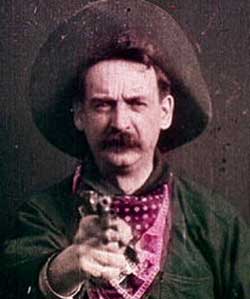
 In reality director Edwin S. Porter was fired with enthusiasm for making a film with narrative drive only after seeing Georges Melies
In reality director Edwin S. Porter was fired with enthusiasm for making a film with narrative drive only after seeing Georges Melies  The train pulls in beneath the water tower & three masked cowboys slip onto the train unseen. Soon there's a shoot-out in the mail car, a man is killed, & the thieves use explosives to open a payrole chest.
The train pulls in beneath the water tower & three masked cowboys slip onto the train unseen. Soon there's a shoot-out in the mail car, a man is killed, & the thieves use explosives to open a payrole chest. There's a chase sequence with blazing guns & one of the gang members is shot from his horse. The other three get away, but momentarily they are found off their horses dividing up their loot, resulting in a big shoot-out, the robbers slain in a blaze of smoking six-guns.
There's a chase sequence with blazing guns & one of the gang members is shot from his horse. The other three get away, but momentarily they are found off their horses dividing up their loot, resulting in a big shoot-out, the robbers slain in a blaze of smoking six-guns.
 The Lubin catalog text for this story describes some scenes different from how they are actually filmed.
The Lubin catalog text for this story describes some scenes different from how they are actually filmed.